
Battus is a New World genus of butterflies that are usually found around pipevine plants. The caterpillars feed off the poisonous pipevines, making the insects poisonous themselves; they taste very bad to ward off predators. Since birds avoid these butterflies, other swallowtail species mimic their coloration. The common North American species are Battus polydamas and Battus philenor.

Battus philenor, the pipevine swallowtail or blue swallowtail, is a swallowtail butterfly found in North America and Central America. This butterfly is black with iridescent-blue hindwings. They are found in many different habitats, but are most commonly found in forests. Caterpillars are often black or red, and feed on compatible plants of the genus Aristolochia. They are known for sequestering acids from the plants they feed on in order to defend themselves from predators by being poisonous when consumed. The adults feed on the nectar of a variety of flowers. Some species of Aristolochia are toxic to the larvae, typically tropical varieties. While enthusiasts have led citizen efforts to conserve pipevine swallowtails in their neighborhoods on the West coast, the butterfly has not been the subject of a formal program in conservation or protected in legislation. The butterfly is however of "Special Concern" in Michigan, which is on the Northern limit of its range.
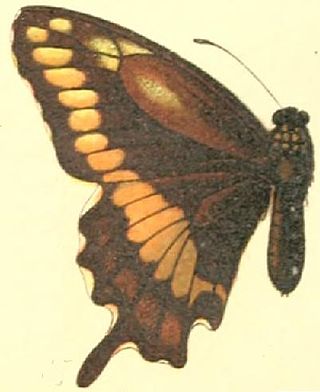
Battus zetides, the zetides swallowtail, is a species of butterfly in the family Papilionidae and is found in Haiti and the Dominican Republic.
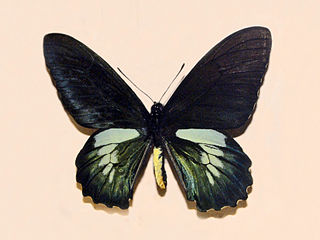
Battus laodamas, the green-patch swallowtail or yellow-spotted swallowtail, is a species of butterfly in the family Papilionidae.
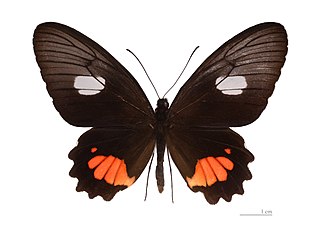
Parides anchises, the Anchises cattleheart, is a species of butterfly in the family Papilionidae native to the Americas. It is common and not threatened. The larvae feed on Aristolochia species including: A. brazilsis, A. bukuti, A. colombiana, A. cymbifera, A. fimbriata, A. inflata, A. macroura, A. odora, A. ringens, and A. triangularis.

Battus eracon, the west-Mexican swallowtail or Colima swallowtail, is a species of butterfly in the family Papilionidae. It is found in western Mexico where it is local and uncommon. The larvae feed on Aristolochia tentaculata.

Battus ingenuus, the Dyar's swallowtail or confused swallowtail, is a species of butterfly in the family Papilionidae.

Battus lycidas is a species of butterfly in the family Papilionidae native to the Neotropical realm. It is commonly known as Cramer's swallowtail, the Lycidas swallowtail, and the yellow-trailed swallowtail.
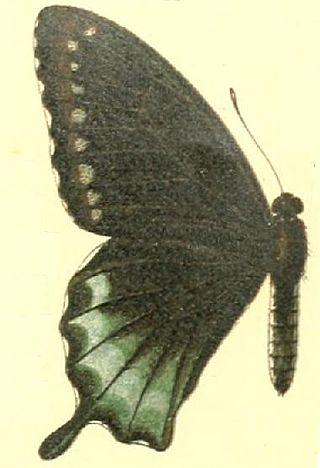
Battus devilliersii is a species of butterfly from the family Papilionidae that is found in Cuba and the Bahamas.
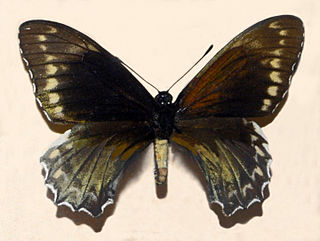
Battus madyes, the Madyes swallowtail, is a species of butterfly from the family Papilionidae.

Battus belus, the Belus swallowtail is a species of butterfly from the family Papilionidae that is found in Brazil, Colombia, Guatemala, Peru and Venezuela.

Battus crassus, the Crassus swallowtail, is a species of butterfly from the family Papilionidae.

Euryades corethrus is a species of butterfly from the family Papilionidae that is found in Brazil, Paraguay, Uruguay, and Argentina.

Euryades duponchelii is a species of butterfly from the family Papilionidae first described by Hippolyte Lucas in 1839. It is found in Brazil, Argentina, Paraguay, Uruguay, and Bolivia.

Parides agavus, the Agavus Cattleheart, is a species of butterfly in the family Papilionidae. It is found in Brazil, Paraguay, and north Argentina.

Parides proneus is a species of butterfly in the family Papilionidae. It is found in Brazil and Paraguay.

Mimoides protodamas is a species of butterfly in the family Papilionidae. The common name is false polysticto, with reference to the similarity of this species with Battus polystictus.

Parides neophilus, the spear-winged cattleheart, is a species of butterfly in the family Papilionidae. It is found in the Neotropical realm.

Parides tros is a species of butterfly in the family Papilionidae. It is found in the Neotropical realm where it is endemic to Brazil.
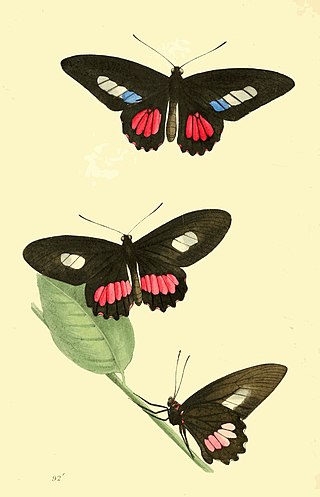
Parides zacynthus is a species of butterfly in the family Papilionidae. It is found in the Neotropical realm where it is endemic to Eastern Brazil.




















